 Last Updated February 9, 2025
Last Updated February 9, 2025
The most common Vitamix shopper’s question is some variant of, “I want to make smoothies, soups, and frozen desserts. Which Vitamix blender is best for me?” The answer is that all Vitamix machines work great for those tasks; which one is best depends on the volumes you want to blend and whether you want to pay for extra features.
If you don’t want to go through the nitty-gritty, here are my quick Vitamix recommendations:
Which is the best Vitamix model?
Best Value
- E310 (short/narrow container for small to medium amounts)
- Recon 5200 (tall/narrow container for small to large amounts)
- Recon E320 (short/wide container for medium to large amounts)
Money Is No Object
- Ascent X5 (latest and greatest)
The February 2025 shopping landscape
Most Vitamix models are on sale through Feb 22nd for the President’s Day Sale. Here is the sale.
Vitamix recently released a new set of Ascent models. Full details are in my Vitamix Ascent X Series Review.
The Food Processor Attachment gives more reason to consider Ascent and Venturist models, since it is not compatible with classic models. If you don’t care about the premium finish of the A3500, consider saving big on the Reconditioned Venturist.
If you are looking for the lowest possible price, I recommend choosing between the Recon 5200, the E310, and the Recon E320. The most significant difference between these models is the container they come with, so use the following Venn diagram to pick the optimal container for you. There are trade-offs between the three container options. To put it briefly, “short, narrow, or large capacity: pick 2”: 
Note to visitors from outside the United States: The model availability described on this page is for the USA (and APO/FPO addresses). If you are shopping from Canada, check out my page about Canadian Vitamix models.
For most people, I recommend choosing from the following four categories: Certified Reconditioned models, Explorian, Premium Classic, and Ascent.
Reconditioned
 If you are looking for the lowest possible price on Vitamix, reconditioned is for you. Some people are hesitant to buy reconditioned, and that is a valid concern with some companies, but Vitamix’s reconditioned units are guaranteed to be top quality. The only reasons I would avoid reconditioned Vitamix are if it is for a gift for someone who won’t understand, or if you want some of the features not available on reconditioned machines.
If you are looking for the lowest possible price on Vitamix, reconditioned is for you. Some people are hesitant to buy reconditioned, and that is a valid concern with some companies, but Vitamix’s reconditioned units are guaranteed to be top quality. The only reasons I would avoid reconditioned Vitamix are if it is for a gift for someone who won’t understand, or if you want some of the features not available on reconditioned machines.
Explorian
 If you prefer a slightly smaller container, I highly recommend the new E310, which comes with a short and narrow 48-oz container (full review). The Explorian E320 is functionally identical to the E310, but it comes with a wide container. That makes it nearly identical to the 5300. (The E320 replaces the 5300 in the model lineup, and it is mostly the same, with a few changes: it does not have the on-off switch on the side, and it does not light up when on. I don’t think these differences matter much, but there they are for anyone wondering about E320 vs. 5300.)
If you prefer a slightly smaller container, I highly recommend the new E310, which comes with a short and narrow 48-oz container (full review). The Explorian E320 is functionally identical to the E310, but it comes with a wide container. That makes it nearly identical to the 5300. (The E320 replaces the 5300 in the model lineup, and it is mostly the same, with a few changes: it does not have the on-off switch on the side, and it does not light up when on. I don’t think these differences matter much, but there they are for anyone wondering about E320 vs. 5300.)
There is now also an Explorian E520, which comes with the wide 64-oz container and adds 3 preset blending modes. With the hidden discount that gets activated after clicking a Vitamix link on this site and then adding the Recon E520 to your shopping cart, it is an excellent deal.
Premium Classic and Propel
If you want the most premium machine, but don’t want the new technology of Ascent, then the Professional Series 750 is for you. I think the Ascent machines are quite nice, but you might not like the look of their digital display, or you might want to be able to use older containers (without NFC chips).
In 2023 Vitamix released a new Series, which they are calling the Propel. Similar to the Pro 750, these machines have preset modes and a secondary on-off switch. The Propel machines also have the subtly updated styling that was released with the Explorian series: Propel 510 and Propel 750.
Ascent (Smart System Blenders)
If you want to buy into the future of Vitamix, the Ascent Series is the way to go. It’s priced in the same range as new Legacy models, but it comes with various upgrades (among them: longer warranty, timer display, can use small cups without bulky adapter, and a wireless connection to smartphone app).

 Within the Ascent Series, the A2300 is the lowest-priced model and it has everything you need. (If you’re buying reconditioned, the A2500 is the lowest-priced model, and it has all the features of the A2300, including full variable speed control, and it adds 3 preset program modes.) If you feel like upgrading, I recommend going all the way up to the A3500, because it has premium finish options. (I’m not saying that the intermediate Ascent models are a bad choice, they just wouldn’t be my choice.) See my Ascent review page for more details.
Within the Ascent Series, the A2300 is the lowest-priced model and it has everything you need. (If you’re buying reconditioned, the A2500 is the lowest-priced model, and it has all the features of the A2300, including full variable speed control, and it adds 3 preset program modes.) If you feel like upgrading, I recommend going all the way up to the A3500, because it has premium finish options. (I’m not saying that the intermediate Ascent models are a bad choice, they just wouldn’t be my choice.) See my Ascent review page for more details.
If you’ve been putting off getting a Vitamix because you’re saving up, you can get one right away with a payment plan. If you make on-time payments, there are zero financing fees.
You can leave a comment below or contact me if you are still having trouble deciding which one to get.
Comparison of pre-Ascent models follows
If you want to quickly see the relation between all of the different Vitamix models, you can jump ahead to my comparison chart.
I made an interactive tool to help explore the different features. Try playing with it to get a sense of which you are interested in. You can click any model to go to its Vitamix.com page, or you can read more about the different models below.
+ Show model selection tool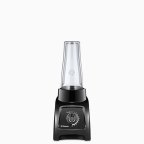 Recon S30
Recon S30  Recon 2-Speed
Recon 2-Speed  Recon 5200
Recon 5200  Recon 5300
Recon 5300  Recon Pro 500
Recon Pro 500 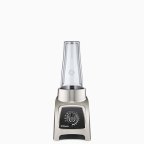 Recon S55
Recon S55  S30
S30  2-Speed
2-Speed 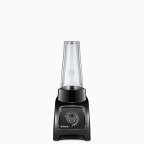 S50
S50  Recon 7500
Recon 7500  5200
5200  S55
S55 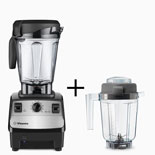 Recon 5300 + 32oz
Recon 5300 + 32oz  Recon Pro 750
Recon Pro 750  7500
7500  Pro 500
Pro 500  Recon 7500 + 32oz
Recon 7500 + 32oz  Pro 750
Pro 750 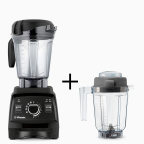 Recon Pro750+32oz
Recon Pro750+32oz  7500 + 32oz
7500 + 32oz  Pro 750 + 32oz
Pro 750 + 32oz  780
780 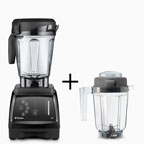 780 + 32oz
780 + 32oz(If you want the 32-oz container, you have to add it to your cart separately: 32-oz container link)
If you’re overwhelmed by the choices and just want to know my preference, I’ve used all of the different types of Vitamix blenders, and before I started using Ascent, the one I used on a daily basis was the 7500, with an extra 32-oz container for blending smaller amounts. (For the best deal, check out certified reconditioned.) All of the models are excellent, and I don’t think there is a wrong choice. (Plus, if you change your mind in the first 30 days, you can get a full refund, including free shipping both ways.)
Summary of Differences
These are the five key decisions to make when deciding which Vitamix to buy:
The following comparison chart shows the relations between the different machines in the S-Series, C-Series, and G-Series. The machines within most boxes of the chart are identical, but they come with different accessories and cookbooks (the exceptions are the S50 and S55, where the S55 has 2 more presets than the S50, and the Pro 750 and Vitamix 780, where the 780 has a flat touchpanel control). Generally the differences in accessories/cookbooks are pretty marginal, so I’d recommend going for the lowest price model within the box.

(“+” indicates there are also more expensive options in addition to the price listed in the chart. The following machines are not shown because they do not fit in with the rest: the Vitamix Turboblend Two Speed and Three Speed lack variable speed control, and the Vitamix 5300 and 6500 are a hybrid of the 6300 and 7500—i.e. they have a 7500 container on a 6300 base, without or with presets.)
Personal Blender? (S-Series vs. C-Series and G-Series)
(Vitamix S30 and S55 vs. 5200, 7500, et al.)
 In 2014 Vitamix released the Vitamix S30. It is smaller than the other Vitamix models, and also comes with a combination blending container/to-go smoothie cup. The Vitamix S50 and Vitamix S55 came out in 2015, and they are the same as the S30 but add preset modes. Since these models are significantly different from all the other models, I put up a detailed Vitamix S30 and S-Series review. If you are considering a smaller blender, or like the idea of blending in a to-go smoothie cup, you should check them out. Not surprisingly, the S-Series’ smaller size means that their maximum capacity is lower the other models (40 oz vs 64 oz).
In 2014 Vitamix released the Vitamix S30. It is smaller than the other Vitamix models, and also comes with a combination blending container/to-go smoothie cup. The Vitamix S50 and Vitamix S55 came out in 2015, and they are the same as the S30 but add preset modes. Since these models are significantly different from all the other models, I put up a detailed Vitamix S30 and S-Series review. If you are considering a smaller blender, or like the idea of blending in a to-go smoothie cup, you should check them out. Not surprisingly, the S-Series’ smaller size means that their maximum capacity is lower the other models (40 oz vs 64 oz).
Variable Speed?
(Vitamix Two Speed vs. 5200 and Vitamix 6000 vs. 6300)
 The variable speed control found on all Vitamix machines except for the Two Speed and 6000 is useful for when you don’t want to fully liquefy your blend. Examples are pesto, salsa, or chopping vegetables. If you don’t have variable speed, you can get away with quickly pulsing, but you won’t have quite as much control. The variable speed also makes the “bubble removal trick” more effective, although pulsing on low speed also works.
The variable speed control found on all Vitamix machines except for the Two Speed and 6000 is useful for when you don’t want to fully liquefy your blend. Examples are pesto, salsa, or chopping vegetables. If you don’t have variable speed, you can get away with quickly pulsing, but you won’t have quite as much control. The variable speed also makes the “bubble removal trick” more effective, although pulsing on low speed also works.
Preset Programs?
(Vitamix Two Speed vs. 6000, Vitamix 5200 vs. 6300, Vitamix Professional Series 200 vs. Professional Series 500, Vitamix S30 vs. S55, and Vitamix Professional Series 300 vs. Professional Series 750)
 The preset programs on the 6000, 6300/Pro 500, S55, and Pro 750 allow you to select a program, turn it on, and then the machine will automatically ramp up the speed and then shut off after a certain amount of time. There are a number of reasons that people appreciate this function:
The preset programs on the 6000, 6300/Pro 500, S55, and Pro 750 allow you to select a program, turn it on, and then the machine will automatically ramp up the speed and then shut off after a certain amount of time. There are a number of reasons that people appreciate this function:
• You can start the machine and “walk away” to do something else.
• If you strictly follow recipes the presets can yield more consistent results.
• Presets can give new users more confidence with the machine.
However, the presets do not work perfectly every time. Sometimes ingredients require tamping to start circulating past the blades, so you can’t always “walk away.” Also, the preset time might not be the optimum blending time if you modify a recipe. You may find that your smoothie is not fully blended after the smoothie program runs, so you have to run it again. A commercial coffee or smoothie shop makes the same recipes over and over, so in that setting presets are extremely useful. If you constantly make new combinations and of differing amounts, as many home users do, the settings may be less useful. It’s not too hard to tell when something is sufficiently blended, and after a few trials anyone should be able to figure it out. For these reasons, I personally would not pay extra for the preset settings. However, I know many people who have the presets love them. One thing to remember is that the machines with presets still have the variable speed knob for full manual control. If you don’t mind the added cost of presets, you can always switch back and forth to manual control.
C-Series vs. G-Series (Next Generation)?
(Vitamix 5200 vs. 7500, and Vitamix Professional Series 500 vs. Professional Series 750)
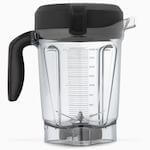 Vitamix released the “Next Generation,” aka “G-Series,” models in 2012. Both the base and the pitcher have an updated design. The base has slightly better sound muffling and also has better airflow which means that it can work harder before it overheats. To go with the better-cooled motor, the updated pitcher has a 4-inch blade instead of the Standard/Classic “C-Series” 3-inch blade. The 4-inch blade is in a shorter and wider container that has the same capacity as the 64-oz C-Series container.
Vitamix released the “Next Generation,” aka “G-Series,” models in 2012. Both the base and the pitcher have an updated design. The base has slightly better sound muffling and also has better airflow which means that it can work harder before it overheats. To go with the better-cooled motor, the updated pitcher has a 4-inch blade instead of the Standard/Classic “C-Series” 3-inch blade. The 4-inch blade is in a shorter and wider container that has the same capacity as the 64-oz C-Series container.
Advantages of the wider design:
• less need for the tamper (ingredients fall into the blades more easily)
• better chopping capability (you can course-chop more ingredients at a time)
• easier to scrape thick mixtures out
Advantage of shorter design:
• easier storage (at 17.5” tall, the container with lid on the base fits under standard kitchen cabinets)
Advantages of the 4-inch blade:
• faster processing time
• under some circumstances, marginally smoother blends
The one disadvantage of the new container is that for small volumes of under ~2 cups it does not work quite as well as the C-Series narrow container. The G-Series wider design causes two things to happen. First, there is more splashing up onto the inside of the lid and upper walls of the container, which means you lose a small amount of your blend unless you carefully scrape off the lid and walls. Second, you need slightly more volume to cover the blades and get good circulation going. The minimum volume to blend depends on what you are blending, and also on how much effort you are willing to spend pushing ingredients back into the blades. For example, for best results, the narrow containers can make nut butter easily by starting with 3 cups of nuts, whereas the wider Next Generation containers do best with 4 cups of nuts. For easier, more liquidy, blends, you can go below 1 cup in either container, but Next Generation containers will splash around more.
This disadvantage is a non-issue if most of your blends are over 2 cups, or if you are willing to spend a bit more to buy an additional narrow container, which will give you the best of both worlds. I like the 32-oz container for this purpose, although the 48-oz container has the same narrow bottom so it works just as well. The 48-oz container is just a bit bulkier on the outside because it sits outside the centering posts instead of inside of them, and its top is wider as well.
(The narrow C-Series Vitamix containers are compatible with G-Series models, but the G-Series containers are not recommended for use on C-Series models. The longer G-Series blades increase the load, and Vitamix does not recommend the C-Series cooling system for those increased loads.)
Reconditioned?
 Buying reconditioned is a great way to save money. For more details on deciding about buying reconditioned, see my refurbished Vitamix page.
Buying reconditioned is a great way to save money. For more details on deciding about buying reconditioned, see my refurbished Vitamix page.
Continue on for more details of each model type…
The array of different Vitamix blenders is a bit confusing, but it turns out that there is a lot of redundancy between the different models. I am only discussing models made for consumer/home use. Their commercial blenders are not ideal for home use because they are generally more expensive and have shorter warranties (3 years vs 7 years for home use; they are warrantied for constant use—think of how many times per day a blender at Jamba Juice runs compared to at your home).
The Vitamix website currently lists over 30 different home models, but they are all variants of three main designs: “personal” (S-Series), “standard/classic” (C-Series), and “next generation” (G-Series). For each of these main designs there are a few different options, to make a total of 8 different machine types. The rest of the models have identical bases, but come with different containers and/or accessories.
S-Series Motors
If the smaller size, dishwasher safe container, and “to-go” blending container appeal to you, please read the full details at my Vitamix S30, S50, and S55 review. For quick reference, the size of the base is 8.3″ deep x 5.9″ wide x 7.7″ tall. With the 20-oz to-go container the total height is 14.55″. The height is 15.66″ with the 40-oz container. These models have lower power, but they are still capable of making all of the usual Vitamix creations, just in smaller quantities.
C-Series Motors (Standard/Classic)
There are three types of bases of the standard variety. The differences are in the controls. The dimensions of the base of these machines are 8.75″ deep x 7.25″ wide x 8.25″ tall. There are three different container size options: 32 oz, 48 oz, and 64 oz, which result in height of base plus container/lid of 16.9″, 17.4″, and 20.5″ respectively.
Standard, no-variable speed (Vitamix TurboBlend Two Speed and Three Speed)
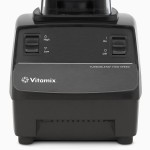 TurboBlend Two Speed (
TurboBlend Two Speed ($399$349); reconditioned for $299. This machine comes with a 5-year warranty and lacks the variable speed knob. Variable speed is useful for cases where you want to have finer control over the texture (i.e. if you don’t want a totally smooth purée). However, you can accomplish some non-liquefying chopping tasks by quickly pulsing the machine. While this is the most affordable new machine, I’d highly recommend looking at the reconditioned 5200, which has the same warranty and adds variable speed for $70 less.
In May 2016 Vitamix came out with a new no-variable speed machine, the TurboBlend Three Speed($499). It is exactly what it sounds like: it has three speed settings: low, medium, and high. It also has a pulse switch, which does the same thing as switching the start-stop button on and off. The pricing on this model is a bit strange, since for $50 less you can get a machine with fully variable speed. Plus, the TurboBlend 3-Speed comes with a 5-year warranty, instead of the 7 years on machines like the 5200.
Standard variable speed (Vitamix 5200 et al.)
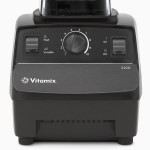 Until recently this was Vitamix’s bread and butter, and they have a lot of models to show for it: 5200 ($449), TurboBlend VS (retired), CIA Pro (retired), Pro 200 ($499), Creations II ($449), and Creations GC (retired); reconditioned for $329. These machines are essentially identical. Some are available with a shorter 48-oz container instead of the 64-oz container. The smaller container is nice because it’s more compact (and fits under standard kitchen cabinets), but of course its capacity is lower. The aesthetics of the switches and dial are slightly different between the different models. The Creations models come with a 5-year warranty, while the rest are 7 years. The 5200 comes with their “whole foods cookbook,” the TurboBlend VS comes with a vegetarian/vegan/raw cookbook and a nutmilk straining bag, the Pro models come with a cookbook with restaurant-oriented recipes (the CIA one—that’s Culinary Institute of America—comes with an additional recipe book). Note that if you buy reconditioned, you cannot choose which of the Standard models you are getting; Vitamix will choose for you based on availability, but remember that functionally they are identical.
Until recently this was Vitamix’s bread and butter, and they have a lot of models to show for it: 5200 ($449), TurboBlend VS (retired), CIA Pro (retired), Pro 200 ($499), Creations II ($449), and Creations GC (retired); reconditioned for $329. These machines are essentially identical. Some are available with a shorter 48-oz container instead of the 64-oz container. The smaller container is nice because it’s more compact (and fits under standard kitchen cabinets), but of course its capacity is lower. The aesthetics of the switches and dial are slightly different between the different models. The Creations models come with a 5-year warranty, while the rest are 7 years. The 5200 comes with their “whole foods cookbook,” the TurboBlend VS comes with a vegetarian/vegan/raw cookbook and a nutmilk straining bag, the Pro models come with a cookbook with restaurant-oriented recipes (the CIA one—that’s Culinary Institute of America—comes with an additional recipe book). Note that if you buy reconditioned, you cannot choose which of the Standard models you are getting; Vitamix will choose for you based on availability, but remember that functionally they are identical.
Sometimes these models are listed with their color-specific SKU. All of the following models are identical to the 5200, they just come with different colors and names: Vitamix 1709, 1363, 1364, 1365, 1709, 1723, 1732. They also sometimes go by VM0103. Vitamix 1978 is also the same, but comes with a 48-oz container.
Standard variable speed + presets (Vitamix 6300 and Professional Series 500)
 Pro 500 ($559) and 6300 (retired); reconditioned for $379. These are the same model; the only difference is that the 6300 comes with the “Savor” cookbook, which has a broader range of recipes than the Pro 500’s “Create” cookbook, which focuses more on restaurant-style recipes that tend to be richer.) They have 3 preset programs that run the blender for a certain amount of time and speed for smoothies, frozen desserts, and hot soups. Their switches are slightly different from the non-preset models. The non-preset models have an on-off switch, a variable speed knob, and a high-variable speed switch. The preset ones have moved the highest speed setting onto the knob and replaced the high-variable speed switch with a pulse switch. This is really a minor aesthetic difference, since you can achieve pulsing on the non-preset models by quickly flicking the on-off switch on and off.
Pro 500 ($559) and 6300 (retired); reconditioned for $379. These are the same model; the only difference is that the 6300 comes with the “Savor” cookbook, which has a broader range of recipes than the Pro 500’s “Create” cookbook, which focuses more on restaurant-style recipes that tend to be richer.) They have 3 preset programs that run the blender for a certain amount of time and speed for smoothies, frozen desserts, and hot soups. Their switches are slightly different from the non-preset models. The non-preset models have an on-off switch, a variable speed knob, and a high-variable speed switch. The preset ones have moved the highest speed setting onto the knob and replaced the high-variable speed switch with a pulse switch. This is really a minor aesthetic difference, since you can achieve pulsing on the non-preset models by quickly flicking the on-off switch on and off.
Some people love the presets because you can set it and walk away (assuming the mixture is circulating and you don’t need the tamper), and because they get more consistent results. However, the more consistent results will only hold if you always add the same quantities and types of items to the blender. For example, if you’re making a small smoothie, you can blend it for less time than if you were making a large one. One other thing is that you can set the non-preset machines and walk away—you just have to come back to stop them. I often use the blending time to rinse off the knife and cutting board that I used. You’re not likely to forget that the Vitamix is running because it’s loud enough to hear throughout the house. The variable speed knob goes to the same high speed as the previous models on high, but it’s lowest setting is a bit faster than on the 5200 et al., so you lose a tiny bit of fine control. Whether the presets are worth it is a personal question—I wouldn’t pay extra for them, but some people love them.
Standard no variable speed + presets (Vitamix 6000)
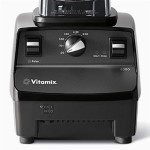 6000 (retired). Released October 2013, this is more of a mash-up of existing machines than a truly new one. It’s a sort of blend between the Two Speed, and the 6300. It does not have variable speed control, but it has six preset timed blending settings. These settings will automatically ramp up the speed, and then turn it off after a specified time of 20 sec, 30 sec, 1 min, 1.5 min, 4.5 min, or 6.5 min. Like the 6300, the pulse control is spring-loaded so that it only stays on as long as you hold it down, and it blends at a medium-low speed.
6000 (retired). Released October 2013, this is more of a mash-up of existing machines than a truly new one. It’s a sort of blend between the Two Speed, and the 6300. It does not have variable speed control, but it has six preset timed blending settings. These settings will automatically ramp up the speed, and then turn it off after a specified time of 20 sec, 30 sec, 1 min, 1.5 min, 4.5 min, or 6.5 min. Like the 6300, the pulse control is spring-loaded so that it only stays on as long as you hold it down, and it blends at a medium-low speed.
G-Series Motors (Next Generation)
In 2012 Vitamix released a new generation G-Series base with improved airflow that makes it run cooler and quieter than the classic C-Series one. With the improved cooling, the G-Series base can use a new pitcher design that is wider and has longer blades. This design makes the tamper less necessary, and makes it easier to get thick mixtures out. The longer blades also process food faster and work better for chopping. The G-Series machines are compatible with the C-Series containers, so if you want to use the dry blade you can use the same classic dry container. Dimensions are 9.4″ deep x 7.7″ wide x 17.5″ tall (with new-style 64-oz container in place). For more details of sizes, check out the PDF footprints I made for my Vitamix S30 review.
Next generation motor (Vitamix 7500, Professional Series 300, and Creations Elite)
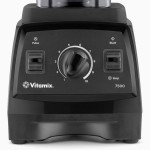 7500 ($529), Creations Elite ($557.50), and Pro 300 ($559); reconditioned for $439. These are all the same machine, so don’t worry about the note on the Reconditioned Next Gen page that says that the label may reflect any of these models. The only difference is the name printed on it. One point of confusion is that the Creations Elite is sold new with a smaller container, but if you happen to get sent a Creations Elite as a Reconditioned Next Gen, it will come with the same low profile 64-oz container that the 7500 comes with.
7500 ($529), Creations Elite ($557.50), and Pro 300 ($559); reconditioned for $439. These are all the same machine, so don’t worry about the note on the Reconditioned Next Gen page that says that the label may reflect any of these models. The only difference is the name printed on it. One point of confusion is that the Creations Elite is sold new with a smaller container, but if you happen to get sent a Creations Elite as a Reconditioned Next Gen, it will come with the same low profile 64-oz container that the 7500 comes with.
Next generation motor + presets (Vitamix Professional Series 750 and Vitamix 780)
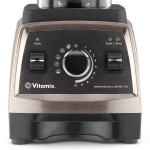
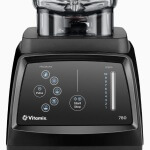 Pro 750 ($599–$649), 780 ($719); available reconditioned: 750 for
Pro 750 ($599–$649), 780 ($719); available reconditioned: 750 for $519–$569$499, and 780 for $519$399. These models have 5 presets: smoothies, frozen desserts, purées, hot soups, and self-washing. If you want to see more details of exactly what the presets do, check out my page about demystifying Vitamix presets. The 780 is identical, except that it has a touchpanel control interface. See my Vitamix 780 review for more details.
Vitamix Heritage 750 vs. Original 750?
In late 2015, Vitamix released a new version of the Pro 750: the Heritage line. The Vitamix Heritage 750 is functionally equivalent to the original Pro 750, but it has two differences on the exterior of the base. The upper shell (see diagram below) is now metal on the Heritage models. The Vitamix website doesn’t put Heritage in the model title, but it’s there in the description.
 The original 750 came in a brushed stainless finish option, but the upper shell was plastic with a thin metallic coat that could be scratched or scuffed. (When I tested the original 750 for a couple of months, I did not see any problems, but I have heard that some people have noticed scratches/scuffs.) The solid metal of the new Heritage models is more durable. Also, the metal shell muffles the the motor a bit more than the plastic, making the Heritage models a bit quieter.
The original 750 came in a brushed stainless finish option, but the upper shell was plastic with a thin metallic coat that could be scratched or scuffed. (When I tested the original 750 for a couple of months, I did not see any problems, but I have heard that some people have noticed scratches/scuffs.) The solid metal of the new Heritage models is more durable. Also, the metal shell muffles the the motor a bit more than the plastic, making the Heritage models a bit quieter.
 The other minor difference is that the Heritage models’ front panel has fewer backlights: Heritage models light up the indicators above the pulse and start-stop switches, whereas the original Pro 750 has backlights around the central knob as well.
The other minor difference is that the Heritage models’ front panel has fewer backlights: Heritage models light up the indicators above the pulse and start-stop switches, whereas the original Pro 750 has backlights around the central knob as well.
The Heritage metal is available in brushed stainless and copper finishes. (Currently on Vitamix.com, the Heritage options are listed on the main Pro 750 page, and the old brushed stainless finish is discontinued.)
I believe it is called Heritage because it is a throwback to the original Vitamix models that had all-metal bases. The plastic that Vitamix has been using for their bases for the past 25 years is extremely durable, so this change won’t affect functional longevity. That said, the elegant finish of the Heritage models will now likely stay unblemished for longer. It’s also nice that Vitamix did not increase the price for this upgrade.
The Vitamix 5300 and 6500
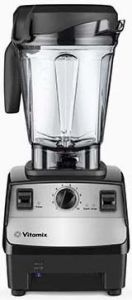 5300 ($529) and 6500 ($599); reconditioned for $360. Vitamix does not currently sell the new models online, only the reconditioned one. These are “new” models for 2015, although they are actually just slightly unexpected mash-ups of previous models. They are a hybrid between a 6300 and a 7500. They use the wide Next Gen (G-Series) container but they have a Classic (C-Series) base. The 5300 has variable speed and a pulse control switch, and has no presets. Meanwhile, the 6500 has the same three presets as the 6300. (Further evidence of equivalence between the 5300/6500 and C-Series models is on the Reconditioned C-Series 6300/Pro 500 page: it says its base may be a 6500.)
5300 ($529) and 6500 ($599); reconditioned for $360. Vitamix does not currently sell the new models online, only the reconditioned one. These are “new” models for 2015, although they are actually just slightly unexpected mash-ups of previous models. They are a hybrid between a 6300 and a 7500. They use the wide Next Gen (G-Series) container but they have a Classic (C-Series) base. The 5300 has variable speed and a pulse control switch, and has no presets. Meanwhile, the 6500 has the same three presets as the 6300. (Further evidence of equivalence between the 5300/6500 and C-Series models is on the Reconditioned C-Series 6300/Pro 500 page: it says its base may be a 6500.)
The reconditioned 5300 is the most affordable option for a machine with the short/wide container.
The strange thing about these models is that previously Vitamix stated that Next Gen containers should not be used on Classic bases because they do not have the updated airflow design that cools the motor more effectively.
I strongly suspect that the 5300 has the same microprocessor speed control as the 7500, Pro 750, and 6300, just without the presets. (You can read about the speed control of the different machines on my Vitamix RPM measurement page.) The microprocessor speed control should help protect the motor when using the wide container at high loads and very low speeds, but at maximum speed it shouldn’t make a difference. The marketing copy for the 5300 says that it comes “with a faster, yet quieter, motor,” but I am skeptical of those claims [Update: interestingly, Vitamix removed that phrase].
The 5300 and 6500 are a bit louder than the G-Series bases, which have sound-dampening technology not present in the C-Series bases. At the same price point, I would prefer the 7500.
Satisfaction Guarantee
Vitamix has a 30-day satisfaction guarantee, so if you have second thoughts you can return a machine within the first 30 days for a full refund and they even pay return shipping.
Warranty
If your machine has any problems during the warranty period of 5 or 7 years, Vitamix will repair or replace it, and they cover shipping costs both ways. For more details about warranties, check out my Vitamix Warranty page.
Reconditioned Vitamix
 I know I already mentioned reconditioned machines, but I want to restate what a great deal I think they are. These factory-refurbished machines offer the best prices you’ll find on Vitamix: 5200 for $329, Pro 500 for $379, and 7500 for $439. For more details, see my refurbished Vitamix page.
I know I already mentioned reconditioned machines, but I want to restate what a great deal I think they are. These factory-refurbished machines offer the best prices you’ll find on Vitamix: 5200 for $329, Pro 500 for $379, and 7500 for $439. For more details, see my refurbished Vitamix page.
Payment Plans
Want to start blending right away, but don’t want to pay the full price up front? Vitamix offers payment plans with zero interest and no fees if you make payments on time. For more information, check out my payment plan page.
Free Shipping
Clicking on any Vitamix link on this page will automatically apply a promotion code, which gives you free shipping on your order of a Vitamix machine (or anything else on Vitamix.com over $50) in the U.S. or Canada. For more details, see my page about the Vitamix promotion code.
Extra Bonus
If you order via a link on this site, Joy of Blending can get a commission. I deeply appreciate your support, and, to thank you, I want to help you get the most out of your new machine. I try to answer all questions from everyone, but sometimes I get swamped. If you order through one of my links, I will give you a private way to contact me so that I can answer your questions before visitors who are not on the special list. Please make sure my link is the last link you click before placing your Vitamix.com order. Then just forward your order confirmation to thanks@joyofblending.com.
Recommended Accessory
I highly recommend a spatula for getting the last bits of thick mixtures out of the container. For the narrow containers I recommend a long narrow spatula. For the wide containers, I recommend Vitamix’s under-blade scraper.
Dry Container
If you’re wondering if you should get a dry container, this new post is for you: Is the dry container worth it?
Phew… so that completes the Vitamix model round-up. I’m looking forward to getting back to describing some actual recipes!
Or follow along on Twitter or Facebook:

Hi Adam,
Thanks for your detailed posting! I have a question…I wanted to buy the recondition 7500 with the new style 64oz container, but when I pressed your link to that model, it brings me to the Vitamix center and their names are all different. I do not see a model 7500. Please help! Thanking you in advance.
Sorry, the links in this post only work from the US. Outside the US Vitamix sells fewer models. If you’re in Canada your choices direct from Vitamix
are currently the Total Nutrition Center, which is the same as the US 5200, and the Aspire, which has the same motor but comes with a shorter 48-oz container and 5-year warranty.Update: See my Vitamix Canada page for the current choices.What exactly does “reconditioned” means?
Not the general sense; just interested what it means for Vitamix products.
Most machines being sold as reconditioned were used as product demos or were customer returns within the 30-day return window, so they generally have not seen much use (note that the same 30-day risk-free trial also applies to reconditioned machines so you can send it back for free if you don’t like it).
But regardless of how they were used, reconditioned Vitamix blenders are tested to perform as new, and if they don’t they are repaired or have components replaced. All reconditioned machines come with brand new containers/tampers. They also come with the same solid warranty/customer support as new machines, just for 5 years instead of the typical 7. (If you’re concerned about warranty length you can extend the warranty to 8 years for $75, less than the cost difference to a new machine.)
We are planning to make a lot of ice cream and blend frozen bananas/fruit– like yonana’s. Any recommendations on the best refurbished model to purchase.. our ninja did an ok job, but did not hold up.
Any Vitamix will hold up to those jobs. Getting thick mixtures out of the container is a bit easier with the Next Generation models. On the other hand, the Standard container will do a better job with small quantities. It depends what you’re blending, but the general rule of thumb is the Next Generation works well down to 2 cups and the Standard container works well down to 1 cup (I’ve blended as little as a quarter cup in the standard container, but that was something easy like salad dressing). Note that you can use standard containers on the Next Generation models, so the ultimate combination would be a 32-oz container paired with the Next Generation machine, but that’s probably overkill for you.
So which is best for you? I’d say probably the Next Generation, but the Standard would also work, and would save you a little money.
Hi Adam,
I found a dealer on Kijiji selling model 4500, have you heard of this model? Please let me know. Thanks.
That’s the Two Speed model mentioned in my post.
Ready to buy a Vitamix! I’m reading about the longer blades, but not sure which models have these other than “new”. If I buy a new 5200S at Costco for $374 which blades are those? Thanks 🙂
The models with the longer 4-inch blades are the Next Generation models (7500, Pro 300, and Pro 750). The Vitamix 5200S is the same as the 5200, and comes with the standard 3″ blades.
Wow. Thank you so much for providing all of this information! I’ve been on the hunt for the perfect Vitamix model for me and this article answered so many of my questions. I’m very close to making my first Vitamix purchase (!!! so excited) and I think I’ve narrowed it down to a reconditioned 5200 or newer generation. Price is a concern (which is why I’m doing reconditioned), but I am willing to pay the extra $70 for the 7500 if it’s money well spent. I do like all of the upgrades, but there isn’t one in particular that helping me make my mind up. In your opinion, do you think the 7500 runs better than the 5200? Also, on the Vitamix website, if you buy a reconditioned 7500 or 5200 are you guaranteed that particular model? I’m an avid Consumer Reports reader and they gave the 5200 a score of 91 and the 750 (they only tested this newer generation model) an 81. I think 750 lost points in convenience and the the ability the blend an ice smoothie. I’ll be using this blender mainly for green smoothies, fruit smoothies, soups and occasionally blending nuts. What are your thoughts? Thanks in advance!
Either machine will do a great job of all of the things you mentioned. Remember that people have been loving their Vitamix machines for many years before the latest round of models came out.
I don’t really have anything to add beyond what I put in the post in terms of if the upgrades are worth it. Only you can decide whether that $70 is worth it to you. If it were me I think I’d go for the 7500.
I have not seen that Consumer Reports review. The one thing I can think of is that for small quantities (under ~2 cups), out of the box, the 5200 will do better than the 7500 because the narrower container means that the same quantity of ingredients will go to a higher level in the container and circulate better. I say out of the box because you could add a 32-oz container to the 7500 and make it match the low volume performance of the 5200; but that’s taking you out of the realm of lowest cost.
Regarding whether you are guaranteed a certain model when you buy refurbished, you may get a model that is equivalent but has a different name. (e.g. you could get a Turboblend VS instead of a 5200, or a Pro 300 instead of a 5200.) But I keep stressing this point: there is absolutely no difference other than what is printed on the front of the machine.
Hi Adam,
I bought the 5200, unfortunately,we don’t have any other models here in Canada. The options is to select the dry container or not, the dry one is pretty pricey $699.99 plus tax in Canada.
I have made hummus, you are right about not being able to scope the bottom of the container! A lot has been wasted there. I was thinking of investing in their spatula, do you think it’s worth spending on? Do you have their spatula?
I do have their nylon spatulas, and I’ve found them to work well. I actually reviewed them in this post.
If I plan to make lots of nut milks, smoothies And almknd butter what would you recommend? The 5200 I can get at costco or the 7500? Is the 7500 industrial strength how does it differ from the 5200?
The 7500 is a newer model that has some nice feature upgrades over the 5200, which I described above in the post in the section titled “Next Generation Motors.” The biggest difference is the shorter/wider container, that makes the tamper less necessary, may be easier to store in your kitchen, and makes getting out thick mixtures like almond butter easier.
I’m not sure how you would define industrial strength. The 7500 has a slightly stronger motor than the 5200, although it’s not a big difference. All Vitamix models have powerful motors that are comparable to heavy duty blenders used in commercial settings.
Adam, thank you very much for your detailed replies. With so many choices and information provided, I’m now a bit uncertain which model to get.
Ideally, payment options and lower price is preferred. With that being said, I am only interested in reconditioned models. Initally, I thought presets were needed, but after your input, I see its a nicesity versus a necessity. My only must have is in the container. I must have a 64 oz container. After reading your replies, I see that these containers come short/wide and tall/narrow. And one of the models come with longer blades. Amongst the Creations GC, 5200, 6300 & 7500, which should I get? Are all containers interchangeable amongst the bases? What is height difference between the two 64oz containers?
The height (with lid) of the tall 64-oz container is 13.4″, and the short 64-oz container is 10.2.” Add ~7″ if they are on the base, take off ~2.5″ without the lid. All containers are interchangeable, except the short/wide 64-oz container is not meant to be used with the Standard models because its longer blades could overload those motors.
You mention preferring a lower price, so unless any of the features of the Next Generation models jump out at you, I’d say go for the reconditioned 5200.
Vitamix offers a payment plan, but to use it you have to make a phone order: 800-848-2649, and you can still get free shipping by telling the representative that you’d like to apply code 06-007021. The Vitamix payment plan has a processing fee of $15 and is 50% cost up front, 25% in 30 days, and 25% in 60 days.
Thanx Adam,
I like the fact that the older model containers can be used on the 7500 base. So I decided to invest a few more dollars and purchase the 7500….reconditioned of course. 🙂 If I find that I’m making smaller quantity smoothies, etc regularly, I will get 32oz container. I am beyond thrilled. Like another reader here, I too have the Omega V350. Now, I have the best of both worlds in my kitchen. Happy smoothe juicing folks.
Thanx Adam, for your priceless contributions.
RED HERRING ALERT!!!
From a physics viewpoint the additional torque load the longer blades in the new short containers is negligible compared to the torque loads already successfully handled by the old 2HP bases with the short bladed containers. After all, the old motors were made to last for decades under the most torque onerous conditions. Lord knows how long the new motors are designed to last – I HIGHLY doubt they are engineered to last as long as the old machines.
Notice the new 64 oz. container is not for sale, even on Amazon, and while I am supposing one can buy a replacement directly from Vita-mix, IT WOULD REQUIRE PURCHASING THE NEW MODEL as the manual (or any paperwork) is NOT available for download on their site.
It’s pretty obvious it’s purely a marketing ploy, based, I presume, on the near indestructability of the existing machines out there. If a person could just buy the new UNDER COUNTERABLE container, why buy a new machine?
I really really WANT the new shorter 64oz container, but at present would have to buy an entire new machine to get one. But I don’t NEED a new machine, so I’ll wait until the new 64oz containers does become available, hopefully sooner than later.
Planned obsolescence Vita-mix style.
BAD Vita-mix.
You raise an interesting point. It’s actually the first thing that went through my head when I saw the new models come out. However, for thick mixtures I’m not sure if you can just dismiss the added torque. Since you mentioned taking a physics viewpoint, I decided to do a quick/rough calculation. How much more torque should we expect from the 4″ blade compared to the 3″ blade for the same angular velocity? The details of the fluid dynamics inside a blender are too complicated to casually consider, but we can make an estimate based on a super-simplified system. Picture a simple rod, and lets calculate the torque needed to rotate it. It has to overcome the drag force, which at every point along the rod is proportional to v^2 (v is the local linear velocity). Now the velocity of a point on the rod is proportional to the radius, r. So the drag force is proportional to r^2. Meanwhile, torque is the product of the perpendicular force and the radius. So torque is proportional to r^3. Now to figure out the total torque for the summation of all points on the rod we integrate. Integrating r^3 yields a r^4 dependence. I don’t have time to draw a diagram or make the equations pretty, but I found this page, which has a diagram, explanation, and better laid out equations for an identical setup. So making the rod 33% longer increases the torque for a given speed by 1.33^4, or 3.1-fold. (A 210% increase in torque.) Now obviously, what’s happening inside the blender is a lot more complicated, since the blade is not a simple rod, and there are edge effects, turbulence, and cavitation. But a ~3-fold increase in torque sounds to me like it could be significant. (For thin liquids I agree that it shouldn’t matter, but I think it could be a problem for thick things that push the limits.)
Since Vitamix has such a generous warranty, it would make sense that they wouldn’t want to sell containers that could break people’s machines even if that might only happen under certain heavy-load circumstances.
There may also be something to your marketing theory. However, I imagine that the majority of Vitamix’s impressive growth (40-50% annually the past couple years) is driven by new owners, rather than repeat buyers. Regarding your doubts about the new machines, their continued success will largely be based on their reputation for quality, so I would guess that they would not want to compromise on engineering.
I wouldn’t count on the short 64-oz container being available any time soon. Are you familiar with the 48-oz containers? They are approximately the same height as the short 64-oz containers, and use the standard blade.
*edit: The math initially had a mistake: going from 3″ to 4″ is a 33% increase, not 25% as previously mentioned. So the difference in torque is 1.33^4 = 3.1, not 1.25^4 = 2.4. So it’s a closer to a 3-fold increase than to a 2-fold increase, as previously stated. The text has been corrected.
How hard is it to overload a old style machine? This illustrates the power of the 2hp machine vs. a 3 hp Vitamix. Essentially no difference for home use. Those motors are TOUGH and will take this level of abuse for YEARS. But on a home cycle, not a commercial cycle, which is what the 3HP machine does, uses that extra horsepower to cool the motor.
http://www.youtube.com/watch?v=yZFzXxB8MqE
For that matter Vita-mix could put a disclaimer on the new 64oz container stating it’s not recommended for use with the older machines. That covers their liability while allowing older machine owners that option.
In any case, with the new machine becoming more prevalent, it’s only a matter of time before those containers become available.
ps. I do know of the 48oz machine.
It’s possible that it is in fact very hard to overload the old-style machines, but I don’t see what comparing the commercial 3-peak-hp machine to the home machine has to do with it. I don’t know what the threshold is, but I know there is one because I’ve heard stories of broken drive-shafts when someone tried to blend a huge block of frozen fruit or a spoon. (Luckily drive-shaft replacement is not that big a deal.) Also, people do sometimes trip the thermal overload sensor on thick mixtures, which would presumably happen more often with a higher load.
By the way, to anyone considering watching that video, I recommend skipping to the 5 minute mark. I don’t understand why he felt the need to show the whole unedited blending process, when at the end he’s just giving a subjective test that the viewer can’t verify—we have to trust him, so we could have just trusted him that he made the two smoothies the same.
Your idea of a disclaimer sounds reasonable to me, but I’m guessing that Vitamix wouldn’t like it, since they tend to like to take a hands-on approach. You could write to them and suggest it though and see what happens.
Well that was 6 minutes of my life I will never get back. LOL
WOW. Just want to give you props Adam. You and your site on comparing the Vitamix blenders is amazing. Thank you for all of your knowledge and help. I think I’m going to get the 7500 refurbished!
I am so happy I found this site…I just started juicing and doing smoothies and im useing a juicer for juicing and a blender for my smoothies..which take forever. My friend suggested I look into Vitamix..what do you recommend for me to get?? thx for the help..I so need it
I’d recommend either the 5200 (Standard) or the 7500 (Next Generation). The 7500 costs a bit more, but its wider shape reduces the need for the tamper, and its shorter height makes it easier to store in some kitchens. If you blend small smoothies (less than ~2 cups) the 5200 is better because its narrower container helps the ingredients cover the blades. If you want the best of both worlds, you can get an additional narrow 32-oz container for the 7500, but that’s overkill for most people. If money is tight, I recommend looking at the reconditioned versions of these machines (see links in the main post above).
Thank you…
Adam…someone is selling this one online..would you be able to tell me if its the 5200 or the 7500?? Vitamix Professional Culinary Series Model VM0103
Thank you so much
Tina
That model sounds like what I referred to as the CIA Pro in my post above, which is the same as the 5200.
One side note for anyone wondering about the Vitamix VM0103 distinction: Vitamix used it on the older 5000 models, and for some reason continues to use it on the current 5200 models.
Thank you so much Adam…you have been so helpful.
Adam do you have any info on the vitamix 5000 series? I bought one used from someone online. It works amazing but I am curious how old it is and how it differs from the newer models? One thing I noticed is that the parts under the blender container are all medal and not plastic like the newer models.
Thanks in advance!
The 5000 was released in the early 90s, and it’s replacement, the 5200 was released in late 2007. So your machine is 6-20 years old. It is very similar to the 5200, but there are a few differences. The first difference is the material of the container; with the 5200 they switched from polycarbonate to co-polyester, which is BPA-free. The container lid and handle were also slightly modified. Vitamix also states that the 5200 is slightly quieter and has a more efficient motor that runs cooler. However, ultimately they are very similar machines.
If you want to know exactly when your machine is from, you can look for a date stamp on various parts. On plastic parts there is sometimes a small circle with a two-digit number in the center, and twelve numbers surrounding it, with an arrow pointing to the outer number. The center number is the year, and the outer number is the month it was made. You can look for this on the bottom of your container (though I think it may not be on the older containers), and I’ve also seen it on the bottom of the rubber centering pad (you can gently pull it up and take it off). I think you mentioned your container has a metal retaining nut; it may have two two-digit numbers stamped into it, one above the other. I believe that top number is the month and the bottom number is the year. Newer machines also have the date of manufacture on the back label, but I don’t think your machine will have that.
Can you tell me if the 7500 pulse switch flips UP for the HIGH speed mode?
Machines with the pulse switch have moved the HIGH speed mode to variable speed 10. Also, the pulse switch is activated by pushing it down (it springs back up on its own).
Thank you for so much helpful info. Is the 5200 with compact container (48oz) available as refurbished?
The 5200 with 48-oz container is sometimes available refurbished, but the supply is a bit sporadic so they are not currently listing it on the Vitamix website. Last I talked to my contact at Vitamix, she had a few available. The best way to find out (and hopefully be able to order one) is to call her directly.
Her name is Barb Hezel, and her number is 1-800-848-2649 Ext 2310.Barb is on vacation so for now call Brenda at 800-848-2649 Ext 2305. You can still get free shipping by telling her you’d like to apply promotion code 06-007021.Thank you. We plan to primarily use the Vitamix to make smaller size smoothies, so from your previous posts, I learned that narrow containers are best. The 48oz size appeals to me because it will fit/can be stored on my counter, but I looked at photos and can’t tell whether the 48 oz has the same narrow design as the 32 oz.? Is the reason you do not recommend the shorter/wider 64oz containers for under 2 cups because it does not blend as smoothly?
At the bottom of the container, where it counts for small volumes, the 48-oz container is narrow like the 32-oz container (and the tall 64-oz container as well). It then flares out higher up to accommodate those extra 16 ounces in the same height container as the 32-oz container. I haven’t used the 48-oz container personally, but I believe it should perform as well as the 32-oz container for small volumes.
Using a container with not enough ingredients (like the wide 64-oz containers under 2 cups) will lead to ingredients bouncing/splashing away from the blades. It may still be possible to blend them smoothly but it will require more coaxing in terms of pushing and/or scraping the ingredients back down into the blades.
The 48-oz sounds like a great choice for you. As I mentioned in an earlier comment, a next generation machine plus a 32-oz container is another good option, but significantly more expensive.
Thank you again for providing so much helpful information and responding so quickly. I ordered my Vitamix today!
So Adam I’ve just bought my reconditioned 7500 and added the 32 oz dry container. Now I’m wondering if I should’ve bought the 32 oz wet container instead and just used it for the dry. I do make small batches although I’ve found that if you have enough liquid you don’t need to tamp and if you see things getting stuck to the sides if you slow it down and speed it up again the content will go back to the center of the container.
What would you suggest returning the dry container and getting the wet or using the 64 oz for small batches and keeping the dry container?
Marty, I don’t think I can tell you what’s best in your situation. 32-oz wet vs dry really comes down to how much dry stuff you make, and if small batches are giving you trouble in the 7500. It sounds like you’re doing OK with the 7500, so my intuition would be to not worry about it. As you’ve found, there are ways of making small batches work–more liquid and modulating the speed both work well. I would say only get the 32-oz wet container if you’re frustrated with thick small batches not working in your wide container.
A week ago I purchased a vitamix 6300. I love it however when I use it for smoothies, I have been using the smoothie setting and it starts blending and then stops mixing however the motor is still running. I try to use the tamper to push down ingredients and it doesn’t help. I then turn it off and use the tamper to move unmixed ingredients down and then turn it on again. Sometimes when I’ve done that it still doesn’t start mixing. I’ve added more liquid to see if it helps but it doesn’t. Am I doing something wrong? I’m thinking the settings are not really worth it if I have to manually intervene. I purchased it from Costco during a demo, but am thinking I should return it and purchase the less expensive model without the settings. Do you think something is wrong with the machine? Maybe I should return this one and buy another 6300 at the next roadshow as maybe something is just wrong with this one.
It’s normal to have to use the tamper with that machine, particularly for thicker blends. You can minimize need for the tamper by cutting ingredients into smaller pieces. You should also aim to put your wettest/softest ingredients in first, and putting hard things like ice on top. In my experience it’s not normally necessary to stop the machine while tamping ingredients down into the blades. You may just need to get the hang of tamping. I agree with you about the limited value of the presets though, because some blends will require manual intervention (especially on that machine—the Pro 750’s wider container makes tamping less necessary).
Thank you for the advice Adam! I Appreciate your input and expertise!
Adam since the 750 is more expensive , do you think I would be comparable to buy a certified reconditioned next generation for 399? Would that be a better machine than to keep the 6300? I used the 6300 again today and a piece of pineapple core was still under the blades.
I personally would choose a reconditioned Next Generation over the 6300, but it’s really up to you. That said, it should be possible to get the 6300 to blend pineapple without getting chunks stuck under the blades. My advice on that issue is to put soft and wet ingredients underneath the pineapple, or if you don’t want any soft/wet ingredients, cut the pineapple up into smaller pieces.
Hey there Adam- I can’t tell you HOW wonderful and informative your review/blog is! Thank you for all your hard work and dedication to this site! I know this may be “beating a dead horse” but I just can’t decide between the 5200 and the pro 750 or 300. My husband and I are just starting on the “green smoothie craze” and we make individual smoothies for ourselves twice a day- about 20 oz each. I’m sure we’ll use it for all the other good reasons too but that is our main reason to buy one for now. Which one would be best for our needs? I like that the Pro versions are the shorter, more compact design- but I’ve also read that if we are just making smaller amounts, the 5200 would be better? Which one is easier to get all the smoothie out of? Thanks sooooo much for your time and information!
20 oz is over 2 cups, so I wouldn’t worry about that being too small a volume for the 750/300. If you’re making really thick smoothies, it’ll be a little easier to get it all out of the new models, but I wouldn’t worry about it too much. If you get a long narrow spatula (Vitamix has a nylon set that I reviewed here), getting thick smoothies out of the 5200 is perfectly easy. If you want to save money, consider the reconditioned units. A 5200 with 48-oz container may also be a good choice for you (see up a few comments, I just answered a question from Victoria about it).
It just so happens that these are the three models that I am considering. Is there one that heats better without having to pulverize vegetables into a cream soup?
I like some chunks to chew as I find that psychologically you feel like you’ve eaten something more substantial. The demo I saw had small chunks and it was hot.
Making organic veggie soup in a few minutes is really the reason that I’m looking at a Vitamix more than smoothies, but I will be making them as well.
Thanks in advance!
All of the Vitamixes heat similarly.
If you want to have a chunky soup the trick is to add some ingredients at the very end and only blend them briefly.
Thank you Adam
Thank you for this awesome website and all of your time answering questions! I get an alert with every question and it has helped me so much! I’m still debating which Vitamix to order when we have the funds pulled together. I’ll primarily be making smoothies, nut butters, ice creams and soups (at least to start). Due to allergies, I’ll probably make separate smoothies for each family member, so they’ll be under 2 cups each which would make me lean towards the old style. But I understand the new style is better for nut butters, correct? What would you recommend knowing I’ll make small quantities but still want to be able to make thick items (butters, ice cream, hummus, etc.)?
If you’ve been following the comments I don’t have too much to add, but I’ll try to answer your questions. For nut butters the main difference with the new-style containers is that they make it a bit easier to get the nut butter out. Getting it out of the old containers is perfectly doable though, particularly if you have a long skinny spatula. You can also use the trick of making a smoothie immediately afterword so that any left-behind nut butter is mixed into the smoothie.
For anyone who is going to regularly blend under 2 cups I recommend getting either a standard style machine (5200 etc.) or a next generation (7500 etc.) plus an additional 32-oz container. So to make the final decision, the question is, do you want to save some money, or pay a bit more for added convenience (ease of getting things out, less need for tamping, shorter height).
By the way, even with the standard machine, I’ve found the 32-oz container is a nice addition if you’re making single servings. The bottom of the container is shaped the same, so there’s no difference in blending, but it’s a bit easier to get stuff out, and it’s just a bit handier because it’s a smaller container.
This site is wonderful, but I still can’t make up my mind! Seems like I am not the only one though. I thought I was all set to buy the Turboblend VS because I am vegan & wanted the cookbook (which is pricey to buy separate) to help me learn how to use the Vitamix. I do have concern about the height of the thing, however, as it will not fit beneath my cupboards in my small kitchen. Then I read that the new compact models might be easier for things like nut butter. Unless, of course, you are making small amounts. It’s just the two of us here and could be only me some of the time, so I might be making smaller amounts of nut milks and smoothies. Why, why, why, do they have to make it so hard to decide?!
You certainly are not the only one! See my answer to Heather just above, since I think it at least partially gets at your concerns. The ultimate would be a 7500 plus a 32-oz container. If you’re concerned about height, the 5200 with 48-oz container is another good option to consider (also possibly available reconditioned—see my reply to Victoria above).
Thank you, Adam, for your quick response. I am comparing the 5200 & 7500 as you suggested and have a couple more questions. The clearance between my cupboards and counter is only 16″, so it looks like none will fit with the container in place. So the main difference for me would be noise level and having a pulse control. Is it worth spending extra to get these two things? I use the pulse control a lot on my Osterizer, mainly to keep the contents from getting air-locked. Also, the reconditioned 7500 comes with a Simply Fresh cookbook, which is not listed under cookbooks you can purchase separately. Is this the same as the Live Fresh book that comes with the Turboblend VS? And finally, does the 32 oz container fit on the 7500? It appears to have a different base shape. I hope to make a decision soon and will definitely use the code you provided since you provide so much helpful information.
The advantage of the 7500 that you didn’t mention is the wider container allows for easier chopping, and in general requires less use of the tamper. I would rank those advantages above the ones you mentioned. You can pulse any machine by flipping the on-off switch, so I wouldn’t rank that feature so high, although again, some people think it’s an awesome feature. It depends on what you’re blending whether the noise level is actually significantly different. If you’re blending ice/frozen things on high, any high-powered blender is going to be quite loud, and the improved motor muffling won’t make much difference. If you’re blending softer things, especially below max speed, then the noise difference becomes significant.
“Simply Fresh” is a different cookbook “from Live Fresh.” The various cookbooks have recipes that are optimized for the different machines, and also try to target different demographics. The “Live Fresh” cookbook is the only exclusively vegan/vegetarian cookbook.
And yes, the 32-oz container does fit on the 7500.